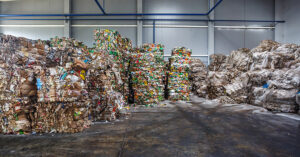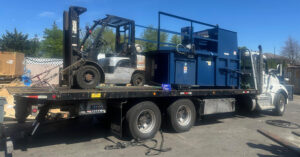Selecting the right compactor for your business is crucial for optimizing waste management, reducing costs, and ensuring compliance with environmental regulations. A properly sized compactor minimizes waste disposal frequency, saves space, and improves operational efficiency. But with various models available, how do you choose the right size compactor?
Understanding your business’s waste output, available space, and hauler requirements is key to making an informed decision. This guide will walk you through the essential factors to consider when selecting a compactor that meets your needs.
Step 1: Assess Your Waste Output
Types of Waste Your Business Produces
Before choosing a compactor, it’s important to determine the type of waste your business generates. Different waste streams require different compacting solutions:
- General Waste – Offices, retail stores, and commercial properties primarily dispose of mixed waste, which may include paper, plastic, and packaging materials.
- Cardboard & Paper – Warehouses, retailers, and distribution centers often handle large volumes of corrugated cardboard and paper waste, making a recycling-friendly compactor essential.
- Organic Waste – Restaurants, grocery stores, and food manufacturers generate wet waste that requires a self-contained compactor to prevent leakage.
- Industrial Waste – Manufacturers and construction sites produce heavy, dense materials that may require a pre-crusher or industrial-grade compactor.
- Hazardous Waste – Medical facilities and chemical plants must comply with strict disposal regulations, often requiring specialized compactors.
Measuring Waste Volume
To determine the correct compactor size, you must measure your waste volume over time. Here’s how:
- Conduct a waste audit by tracking waste disposal over a 30-day period.
- Weigh your waste bins before disposal to estimate daily and weekly output.
- Analyze seasonal trends—does your waste increase during peak business months?
By understanding your waste type and volume, you can narrow down the best compactor size for your operations.
Step 2: Consider Space Constraints and Location
Available Space for a Compactor
Not all businesses have unlimited space for a compactor. Consider the following:
- Indoor vs. Outdoor Placement – If indoor space is limited, outdoor installation may be necessary, requiring weatherproofing considerations.
- Overhead Clearance – Ensure there is enough space for the compactor’s lid or hopper to open.
- Site Access – Haulers need sufficient clearance for waste collection without disrupting business operations.
Ease of Access for Waste Disposal and Collection
Efficiency is key when integrating a compactor into daily operations. Think about:
- Placement Near Waste Generation Points – Reduces employee travel time when disposing of waste.
- Truck Access for Pickups – Ensure haulers can easily access the compactor without obstruction.
- Employee Workflow – The compactor should not disrupt normal business operations.
Step 3: Choose the Right Type of Compactor Based on Business Needs
Stationary vs. Self-Contained Compactors
- Stationary Compactors – Ideal for dry waste, they remain fixed in place while a detachable container collects waste. Best for retailers, warehouses, and manufacturers.
- Self-Contained Compactors – Designed for wet waste, these compactors feature an integrated container to prevent leakage. Perfect for restaurants, hospitals, and food processing plants.
Vertical vs. Horizontal Compactors
- Vertical Compactors – Space-saving and cost-effective, these are ideal for small businesses with moderate waste output, such as convenience stores and offices.
- Horizontal Compactors – Continuous-feed systems designed for high-volume waste generators like distribution centers and large manufacturers.
Specialty Compacting Solutions
For unique waste management needs, consider:
- Auger Compactors – Ideal for industrial operations requiring high compaction efficiency.
- Pre-Crusher Compactors – Useful for breaking down large, bulky items before compaction.
- Portable Compactors – Mobile units suited for temporary waste management at construction sites.
Step 4: Determine Waste Collection and Hauler Requirements
Hauler Agreements and Pickup Frequency
Selecting the right size compactor also depends on your hauler’s pickup schedule and container capacity. Consider:
- Pickup Frequency – A smaller compactor may require more frequent pickups, increasing hauling costs.
- Hauler Restrictions – Some waste collection services have specific size or type requirements for compactors.
Compaction Ratios and Cost Savings
A higher compaction ratio means fewer hauls, leading to:
- Lower disposal costs
- Reduced environmental impact due to fewer trips
- More efficient use of storage space
Step 5: Factor in Long-Term Costs and ROI
Initial Investment vs. Long-Term Savings
While larger compactors may have a higher upfront cost, they often lead to greater long-term savings through:
- Lower hauling fees due to reduced pickups.
- Improved efficiency in waste handling, saving labor costs.
- Potential rebates from recycling compacted materials.
Maintenance and Repair Considerations
To ensure your investment lasts:
- Choose a model with low maintenance needs and durable construction.
- Opt for a compactor with readily available replacement parts and service plans.
- Consider warranty and financing options to reduce upfront costs.
Step 6: Ensuring Safety and Compliance
OSHA and EPA Regulations
Proper safety and environmental compliance are non-negotiable. Your compactor should:
- Follow OSHA regulations for operator safety.
- Comply with EPA waste disposal guidelines.
- Include safety features like emergency stop mechanisms and proper signage.
Employee Training and Best Practices
To prevent injuries and maximize efficiency:
- Train employees on proper operation and loading procedures.
- Implement a routine maintenance schedule.
- Establish safety protocols for handling hazardous waste.
Conclusion: Find the Perfect Compactor with Nanoia Recycling Equipment
Choosing the right size compactor for your business is essential for cost savings, efficiency, and compliance. By assessing waste output, space constraints, and hauler requirements, you can select a compactor that optimizes your waste management operations.
At Nanoia Recycling Equipment, we specialize in designing and installing compactors tailored to your business’s needs. From stationary and self-contained compactors to custom waste management solutions, we handle everything from financing and installation to repairs and maintenance.
For expert guidance on selecting the best compactor for your business, contact us today.






